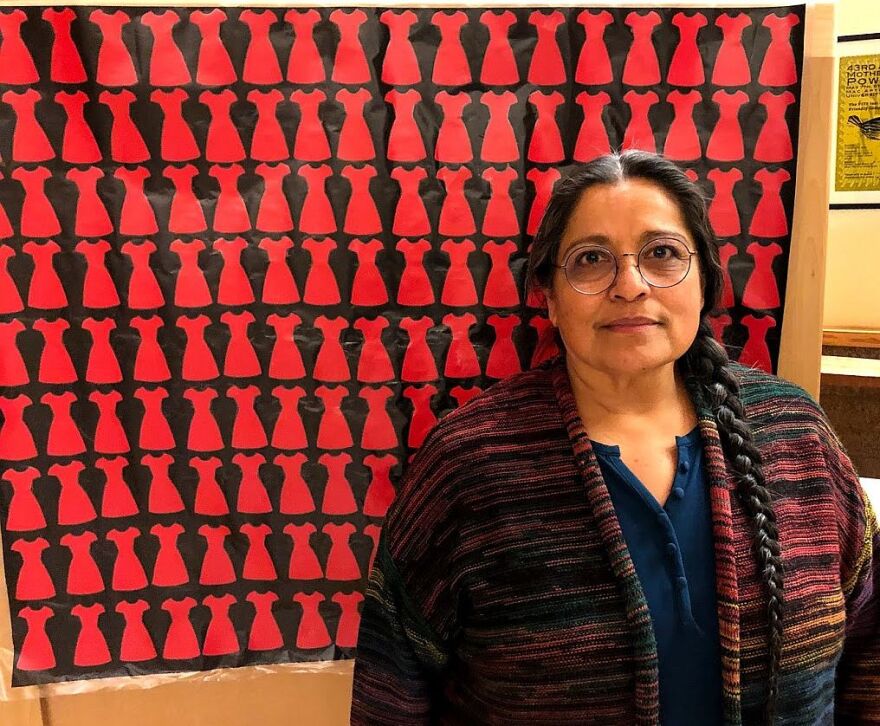There are more than 5,700 missing and murdered indigenous women across North America. As KLCC’s Brian Bull reports, a new Oregon law has launched a series of statewide conversations on the issue.
State police and government officials are visiting tribal communities on reservations and in urban areas to discuss House Bill 2625. Signed into law last year, it directs police to find ways to improve investigations of missing and murdered native people.
The statistics are troubling, to say the least. 84 percent of Native American women experience violence in their lifetime, according to the National Institute of Justice. And a 2008 study found that women in some tribal communities were 10 times more likely to be murdered than the national average. The median age of victims was 29, though the oldest was an 83-year-old woman, and the youngest was an infant not even a year old.
And the lack of data on this trend is also disturbing. Of the 5,712 victims listed as either murdered or missing, only 116 were in a database maintained by the U.S. Department of Justice.

The bill’s sponsor, State Representative Tawna Sanchez, was at a recent event at the University of Oregon in Eugene. Of Shoshone-Bannock, Ute, and Carrizo heritage herself, Sanchez says it’s important tribal communities get support.

“We know every day when people go missing in urban areas or even in rural areas, there’s an all-out force to find them," she tells KLCC.
"There are people’s faces who show up on the news all the time, but that doesn’t happen in Indian Country. And we want that to change.”
Sanchez says some tribes even lack jurisdiction to investigate crimes that occur on tribal lands, due to old laws such as PL 280. Recent legislation such as the Violence Against Women Act has helped tribes better prosecute perpetrators, though some haziness still occasionally surrounds jurisdictional powers, which can involve non-Indian offenders.
On top of that, Rep. Sanchez says there remains scant media coverage of the problem. She says in conversations with tribes, there are often people who know more about a death or disappearance than they may share, owing to either a distrust of police, or uncertainty as to how the media may portray their community.
During the discussion moderated by Gillian Fischer, a Judiciary Committee analyst with the Legislative Policy and Research Office, the students related feelings of futility, despair, and fear when dealing with missing persons cases or suspected homicides. One young woman said victims of domestic violence worry that if they report an abuser, social workers will come to take away their kids "because they failed to provide a safe environment."
Rep. Sanchez says sometimes a suspect is a close relative or someone with wide political influence, making witnesses hesitant to report them for fear of retaliation. And many reservations are remote, with residents scattered about with just a small police force to protect them.

Several people present said even if a call is made, law enforcement may take a full day to respond. In that time, anything can happen that would prevent a timely intervention or arrest.
Sanchez says there was a case involving a Umatilla woman who had died, that raised questions.
"There were people who...told state police, 'We don't believe that was an accidental death, an accidental drowning.'
"Because the person ended up in the river just below the house of her boyfriend at the time. And they knew that there had been domestic violence, they knew that there had been issues. But it wasn't actually investigated like that, even though people brought that up."
The listening tour sessions will all collectively inform a final report that’ll be submitted to the state legislature by mid-September.

So far, two out of at least a dozen planned visits have been carried out. The University of Oregon event was one of the few for urban Indian communities, which may also include a couple events in Portland.
Second-year student Violet Johnson is a Hupa Valley Indian of Yurok descent. She made an exhibit of 1,000 miniature red dresses. They symbolize some of the 5,712 women reported disappeared -or murdered- since 20-16.
Johnson says she did the project in order to educate people about the systemic violence against native women that many people don’t know anything about.
"It’s my duty to be involved in these conversations, and to uplift other native women to talk about their experiences.”
Both Johnson and Sanchez also talked about historical trauma. Many feel that decades - even centuries - of violent oppression can be registered across generations, causing turmoil or deep psychological problems within a culture. Johnson says she's the child of a survivor of violence, which will "be part of my life forever."

Johnson tells KLCC she was overall pleased with the U of O listening session, though the turnout was strongest for those representing the task force charged with carrying out the event. She says promotional flyers announcing the presence of state police may have deterred some of her classmates from showing, as there have been conflicts between law enforcement and tribal members in years past that could still foster mistrust or caution.
As for progress, Johnson calls these sessions "baby steps" that'll help indigenous people and officials work towards a solution.
Copyright 2020, KLCC.







